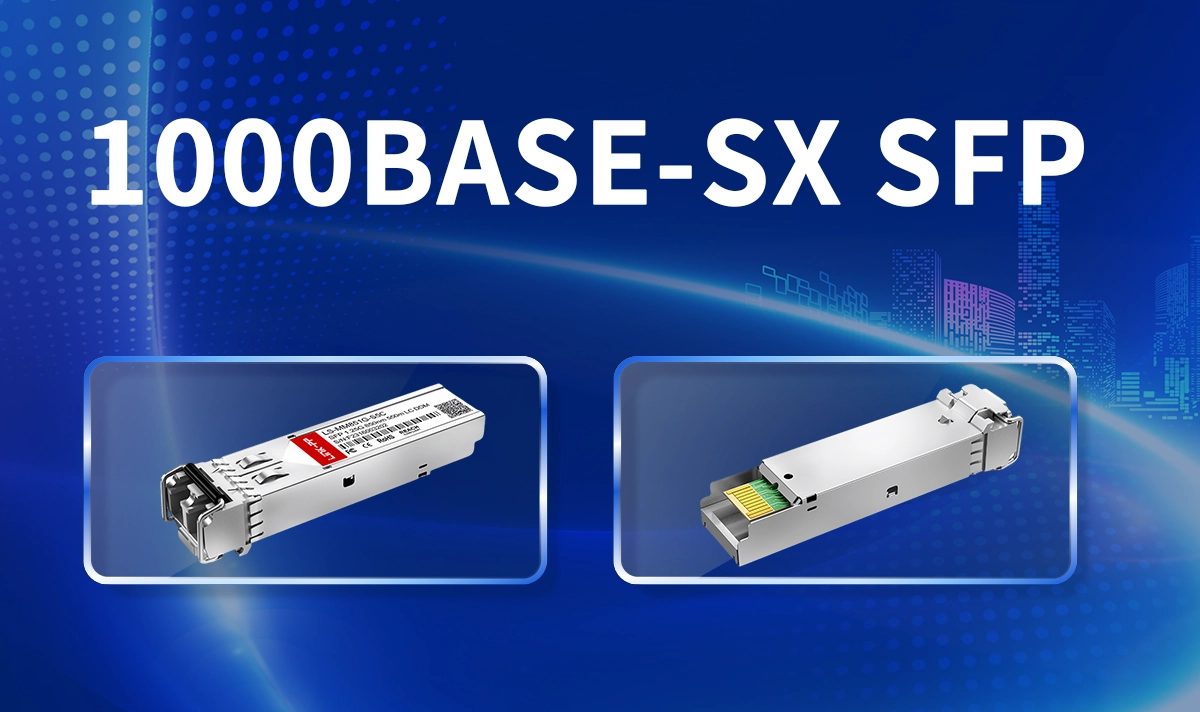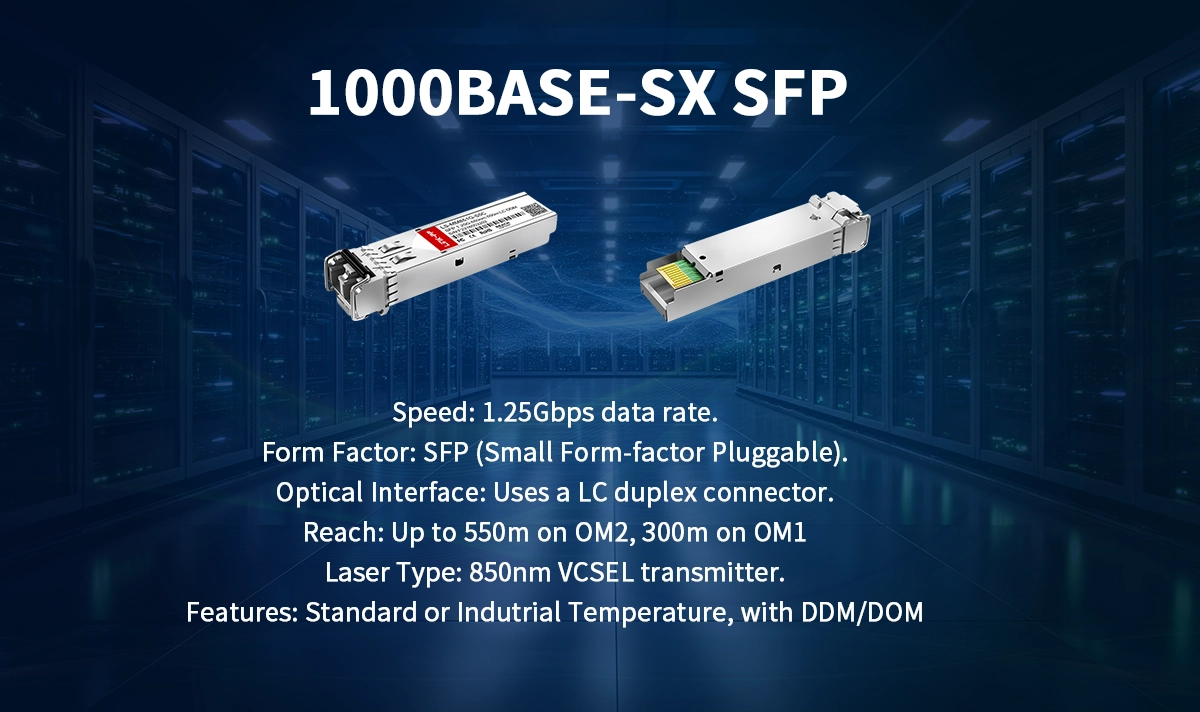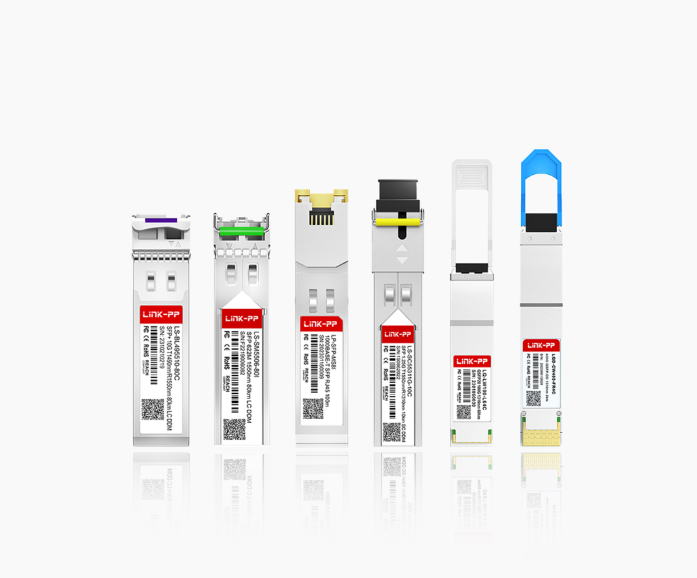
Gigabit Ethernet remains the backbone of countless enterprise and data center networks. When deploying high-speed links over relatively short distances using cost-effective multimode fiber (MMF), the 1000BASE-SX SFP transceiver is the undisputed workhorse. Understanding its specifications, capabilities, and optimal deployment scenarios is crucial for network engineers and IT procurement specialists.
➤ What is a 1000BASE-SX SFP Module?
A 1000BASE-SX SFP (Small Form-factor Pluggable) is a hot-swappable, compact optical module designed for Gigabit Ethernet (1000Mbps) communication. The "SX" designation signifies its use with short-wavelength (850nm) lasers over multimode fiber (MMF). These modules convert electrical signals from network switches/routers into optical signals for transmission over fiber cabling and vice versa, enabling high-bandwidth, low-latency connections.
Core Technology & How It Works
Laser Source: Utilizes a Vertical-Cavity Surface-Emitting Laser (VCSEL) operating at 850nm. VCSELs offer reliability, lower power consumption, and cost-effectiveness compared to Fabry-Perot lasers.
Fiber Type: Designed specifically for multimode fiber (OM1, OM2, OM3, OM4). The core diameter of MMF (50µm or 62.5µm) allows multiple light paths (modes).
Duplex LC Connectors: Industry-standard LC duplex interfaces ensure easy cabling.
Encoding: Uses 8B/10B line encoding (1.25Gbps line rate for 1Gbps data).
Key Specifications & Performance
Understanding the distance limitations based on fiber type is critical for successful deployment:
Fiber Type | Core Diameter (µm) | Max Distance (1000BASE-SX SFP) |
|---|---|---|
OM1 (62.5µm) | 62.5 | 300 meters |
OM2 (50µm) | 50 | 500 meters |
OM3 (50µm - Laser Optimized) | 50 | 550 meters |
OM4 (50µm - Laser Optimized) | 50 | 550 meters+ |
Data Rate: 1.25Gbps (Gigabit Ethernet)
Wavelength: 850nm
DOM Support: Most modern SFPs, including LINK-PP LS-MM851G-S5C, support Digital Optical Monitoring (DOM), enabling real-time monitoring of temperature, voltage, Tx/Rx power via the host device.
Low Power Consumption: Typically < 1W.
Compliance: MSA (Multi-Source Agreement) standards ensure interoperability between vendors.
Primary Applications & Use Cases
Building Backbones: Connecting floors or wings within an enterprise building.
Data Center Racks: Top-of-Rack (ToR) to Aggregation switch links.
High-Performance Workgroups: Linking servers or high-demand workstations.
Fiber to the Desk (FTTD): For environments requiring EMI immunity or future-proofing.
Security Systems: High-bandwidth video surveillance networks.
➤ Choosing the Right 1000BASE-SX SFP: Compatibility & Quality
While 1000BASE-SX SFP compatibility is generally high due to MSA standards, consider these factors:
Host Device Vendor Coding: Some switches (Cisco, Juniper, HPE) require specific vendor ID coding. LINK-PP 1000BASE-SX modules offer broad compatibility and can often be coded for major brands (always verify compatibility).
Fiber Plant: Match the module to your installed fiber type (OM1/OM2/OM3/OM4) and required distance. Need 500m? OM3/OM4 is essential.
DDM(DOM) Support: Crucial for proactive network monitoring and troubleshooting.
Quality & Reliability: Avoid counterfeit SFP modules. Choose reputable manufacturers like LINK-PP that offer rigorous testing, warranties, and performance guarantees. Genuine LINK-PP optical transceivers ensure signal integrity and longevity.
Troubleshooting Common 1000BASE-SX SFP Issues
Link Down:
Verify fiber type (must be MMF) and distance limits.
Check fiber polarity (Tx on one end must connect to Rx on the other).
Inspect LC connectors for contamination (clean with approved tools).
Ensure module is fully seated in the SFP cage.
High Error Rates:
Check DOM readings for marginal Tx power or low Rx power.
Inspect fiber for bends, breaks, or poor splices/connections.
Verify fiber core diameter matches module expectations.
➤ Why Choose LINK-PP 1000BASE-SX SFP Modules?

LINK-PP stands out in the competitive optical module market by offering:
High Performance & Reliability: Rigorously tested LINK-PP transceivers meet or exceed IEEE 802.3z and MSA specifications for seamless integration.
Cost-Effectiveness: Significant savings compared to OEM modules without compromising quality – perfect for budget-friendly network upgrades.
Extensive Compatibility: LINK-PP 1000BASE-SX modules are designed for broad interoperability across major switch brands.
Full DOM Support: Real-time monitoring capabilities for proactive network management.
Lifetime Warranty & Technical Support: Confidence in your investment backed by expert assistance.
➤ Conclusion: Powering Efficient, High-Speed Connectivity
The 1000BASE-SX SFP remains a vital component for deploying robust, high-performance Gigabit Ethernet networks over multimode fiber infrastructure. Its combination of speed, affordability, and relative ease of deployment makes it ideal for countless enterprise and data center applications.
Ready to optimize your network with reliable, high-performance optics?
>> Shop LINK-PP LS-MM851G-S5C 1000BASE-SX Modules Today! <<
➤ FAQ
Can you use a 1000BASE-SX SFP with single-mode fiber?
You should not use a 1000BASE-SX SFP with single-mode fiber. This module works best with multimode fiber. Using single-mode fiber may cause weak signals or no connection.
How do you know if your device supports 1000BASE-SX SFP?
Check your device’s manual or look for SFP ports labeled “SX” or “1G.” You can also visit the manufacturer’s website for a compatibility list. Always match the SFP type to your device’s specifications.
What happens if you mix different SFP types in one switch?
Mixing SFP types can cause network problems. You should use the same type on both ends of a link. For example, use 1000BASE-SX SFPs on both sides for a stable connection.
Do you need to clean SFP connectors before use?
Yes! Dust or dirt can block the light signal. Always clean the LC connectors with a fiber cleaning tool before plugging them in. This step helps you get the best performance and prevents connection issues.




